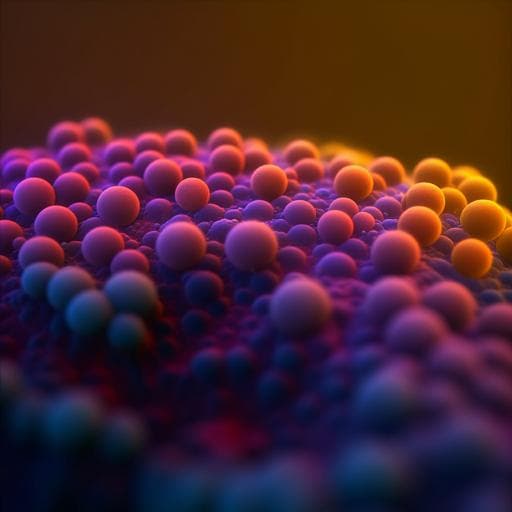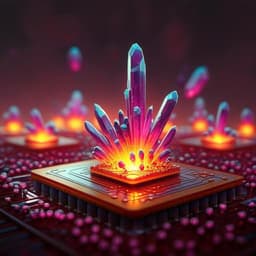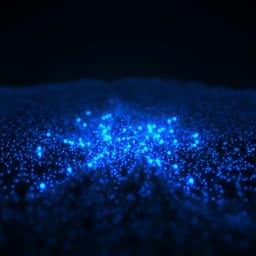
Engineering and Technology
Quantum dot-integrated GaN light-emitting diodes with resolution beyond the retinal limit
J. Bae, Y. Shin, et al.
This groundbreaking research by Junho Bae, Yuseop Shin, Hyungyu Yoo, Yongsu Choi, Jinho Lim, Dasom Jeon, Ilsoo Kim, Myungsoo Han, and Seunghyun Lee introduces an innovative microscale LED array featuring quantum dot-based color conversion, effortlessly surpassing the retinal limit with a stunning 1270 PPI resolution. Discover how advanced techniques are revolutionizing high-resolution displays.
~3 min • Beginner • English
Introduction
Displays that exceed eye-limiting resolution are essential for augmented/virtual reality and ultrahigh-resolution screens used in near-eye head-mounted displays, which demand sub-10 µm pixels, ultrafast response, high luminance, and high contrast. Transmissive LCDs have lower efficiency and contrast, and their pixel density is limited by production constraints. OLEDs improve efficiency and dynamic range but face solvent compatibility challenges for ultrahigh-resolution patterning, response-time-related latency, and degradation/lifetime issues at high luminance. Inorganic micro-LEDs (e.g., GaN) promise high efficiency, long lifetime, and high brightness and can be integrated with CMOS, but fabricating sub-10 µm pixels at wafer scale presents challenges including wafer warpage from residual stress and lattice/thermal mismatches, and sub-micron alignment tolerance during bonding.
This work targets two core challenges for full-color emissive displays beyond retinal resolution: (1) enabling wafer-scale transfer of GaN epilayers to a silicon substrate with lithography-level alignment by bonding before LED patterning to facilitate future CMOS integration; and (2) achieving high-quality RGB color conversion with spectrally pure, solvent-free, ultrahigh-resolution QD patterning. A thin, etchable eutectic bonding alloy and robust substrate removal/etching enable stress relaxation and precise alignment. For full-color conversion, QDs offer narrow emission, tunability, and high quantum yield, but conventional FMM and inkjet methods struggle at sub-10 µm and solvent-based lithography degrades QD performance. The authors introduce a dry, elastomeric-mask-assisted patterning strategy leveraging SAM-based surface energy control to form thick, uniform, high-resolution QD layers suitable for efficient color conversion.
Literature Review
- LCD limitations: lower energy efficiency and contrast versus emissive tech; pixel density constrained by production methods.
- OLED advances: high efficiency and dynamic range; recent patterning breakthroughs (e.g., metasurface-driven sub-100 nm pixels and >10,000 PPI; 10 µm full-color OLEDs). Persistent challenges include response-time-related latency and lifetime under high luminance.
- Micro-LED promise: Inorganic GaN micro-LEDs enable high luminance, efficiency, and longevity; flip-chip bonding to Si enables CMOS integration, but miniaturization to a few µm complicates alignment and yield.
- Wafer warpage and alignment: GaN epilayers are typically grown on sapphire or silicon; residual stress and thermal expansion mismatch induce wafer bowing. GaN-on-Si provides lower warpage versus GaN-on-sapphire owing to closer thermal expansion match and cost advantages; prior work transferred GaN epilayers (e.g., JBD) to Si IC wafers; manufacturability of GaN-on-Si microdisplays has been reported.
- QD color conversion: QDs provide narrow spectra and high quantum yields for RGB conversion. Conventional fine metal masks and inkjet printing face resolution/yield limits and nozzle/mask issues. Direct lithography is incompatible due to QD solvent sensitivity and performance degradation. Alternative approaches: UV light-driven ligand crosslinking (LiXer) can pattern ~3 µm features but require multiple cycles to build thickness; QDs/thiol-ene photo-polymer composites patterned by DLP to ~6 µm involve solvent rinsing. The present work introduces solvent-free, wafer-scale, high-resolution QD patterning using SAM-controlled surface energy and elastomeric topographical masks to achieve thick layers for efficient conversion.
Methodology
Wafer-scale GaN epilayer transfer and µ-LED formation:
- Adopt a bond-first, pattern-later approach to achieve lithography-level alignment between the GaN epilayer and a foreign silicon substrate, enabling future direct CMOS integration.
- Deposit a thin (<5 µm), etchable eutectic bonding alloy stack (Ti/Sn/Ni) by e-beam evaporation to provide strong mechanical bonding while allowing via formation through the bonding layer; avoid In/Au to minimize thermal diffusion, voids, and cost.
- Bond the GaN-on-Si epiwafer to the target wafer; remove the bulk Si from the GaN-on-Si source wafer via HNA (HF/HNO3/CH3COOH) wet etch while passivating the other wafer with SiN; follow with lapping and RIE to planarize and expose a smooth GaN epilayer.
- Define 5 µm-wide LED mesa structures by RIE with Cl2 and BCl3. Form transparent contacts using ITO augmented by a metallic mesh to reduce sheet resistance and improve uniform current injection across large arrays; evaluate mesh densities (1, 4, 9, 16 pixels per grid) for trade-offs between resistance and optical blocking.
Surface energy control and elastomer-assisted QD dry patterning:
- Use self-assembled monolayers (SAM) to tune surface energy on a glass carrier: apply perfluorooctyl trichlorosilane (FOTS) by drop-casting for 2 minutes (vapor treatment gave too low surface energy for subsequent spin coating).
- Spin-coat a PMMA support layer (996 kg/mol, 3 wt/vol% in non-polar toluene) to ~560 nm and bake at 120 °C for 10 min; coat photoresist (PR) and perform standard photolithography. Etch exposed PMMA using O2 plasma (removing FOTS in exposed areas simultaneously) to open patterned holes.
- Treat PR and glass with CF4-based RIE to reduce adhesion (fluorination), improving QD retention on the substrate after lift-off.
- Spin-coat QDs (CdSe core/CdZnSe shell, TiO2 ligands; green ~4 nm, red ~7 nm diameter) and thermally cure (e.g., 100 °C for 2 min, 180 °C for 10 min). Use an adhesive polymer to peel off the PMMA/PR elastomeric mask, leaving the patterned QD film on the glass without exposing QDs to any liquids.
- For double-patterning (RGB): form and cure green QDs (90 °C and 180 °C for 2 min each), deposit a room-temperature PVD SiO2 passivation layer, then pattern red QDs using the same dry process. QD arrays with 10 µm and 5 µm pixels were demonstrated.
Integration with micro-LEDs and optical structures:
- Fabricate blue-emitting GaN µ-LED arrays (5 µm pixel size). Prepare the red/green QD color-conversion layer on a thin glass plate with lithography-level precision. Align and bond the QD-coated glass to the LED wafer using a microscope and micro-positioner with an epoxy layer; the final RGB pitch was 20 µm (size differences arise from the gap between the LEDs and QD layer).
- Investigate peripheral optics to improve color purity and reduce crosstalk: design and fabricate a distributed Bragg reflector (DBR) with alternating SiO2/TiO2 thin films (total target thickness ~605 nm), simulated with Essential Macleod, to reflect blue and improve RGB spectral purity.
Measurements and definitions:
- Electrical and optical characterization of arrays including 10,000–20,000 pixel panels; assess current-voltage behavior and light output with different hybrid mesh designs.
- Quantum efficiencies measured using QE-1100 (Otsuka Electronics):
• EQE(%) = blue absorption (%) × IQE.
• Blue absorption = (Total blue power – blue leakage)/Total blue power.
• IQE = Converted (R or G) light power/(Total blue power – blue leakage).
Power obtained by integrating spectra over defined bands (e.g., blue 430–490 nm). Due to instrument spot size, QE measured on non-patterned QD films on the LED array.
- Spectral measurements with AvaSpec-ULS3648, probe station, and Keithley 2602B; derive CIE coordinates from spectra.
Key Findings
- Successfully transferred GaN epilayers and fabricated 5 µm-pixel GaN micro-LED arrays on a silicon substrate using a bond-before-pattern process, enabling lithography-level alignment suitable for future CMOS integration.
- Achieved an emissive microdisplay prototype with a resolution of 1270 PPI, exceeding the retinal limit.
- Mitigated wafer warpage/alignment issues by using a thin Ti/Sn/Ni eutectic bonding layer and subsequent substrate removal, lapping, and RIE to relax residual stress and expose a flat GaN epilayer.
- Implemented hybrid transparent electrodes (ITO + metal mesh) to reduce sheet resistance and improve uniformity across large arrays (e.g., 20,000 pixels). Among mesh designs (1, 4, 9, 16 pixels per grid), mesh design 2 (four pixels per grid) provided the highest light output efficiency, balancing resistance reduction and optical blockage.
- Demonstrated solvent-free, elastomeric mask-assisted QD patterning with SAM-based surface energy control, achieving uniform 10 µm and 5 µm QD pixel arrays and sequential patterning of green and red QDs.
- Integrated red/green QD layers with blue GaN µ-LEDs to realize full RGB pixels with a 20 µm RGB pitch.
- Optical characterization showed that increasing QD film thickness increases blue absorption and reduces leakage but leads to saturation of external quantum efficiency (EQE) due to self-absorption/reabsorption, scattering, and reduced transmittance at larger thicknesses.
- Measured EQE trends: green QD layers exhibited ~32.5–37% EQE for ~3–5.5 µm thickness; red QD layers showed ~37–38% EQE for ~4.5–5.5 µm thickness, comparable to literature benchmarks.
- DBR structures (SiO2/TiO2) enhanced color purity by reflecting blue light and reducing optical crosstalk, yielding narrow R/G/B spectra and improved chromaticity coordinates.
Discussion
The study addresses fundamental challenges for ultrahigh-resolution near-eye displays by integrating two key innovations: (1) a wafer-scale, bond-first epilayer transfer of GaN onto silicon that enables lithographic alignment and paves the way for direct CMOS pixel-level driving; and (2) a solvent-free, high-fidelity QD patterning process that produces thick, sub-10 µm RGB color-conversion layers with high spectral purity. The hybrid ITO/mesh electrode design resolves current spreading issues across large pixel arrays, optimizing light output without excessive optical blockage. The QD thickness dependence of conversion efficiency clarifies the trade-off between absorption and reabsorption/scattering losses, guiding thickness optimization to maximize EQE. Incorporation of DBR structures demonstrates the importance of optical periphery to suppress blue leakage and improve color purity, directly tackling crosstalk limitations in dense arrays. Collectively, these results demonstrate a viable pathway to full-color, emissive microdisplays with beyond-retinal resolution, ultrafast response, and compatibility with integrated silicon electronics, critical for AR/VR and other high-luminance applications.
Conclusion
This work demonstrates a wafer-scale route to full-color microdisplays beyond the retinal limit by combining bond-before-pattern GaN epilayer transfer onto silicon with solvent-free, elastomeric mask-assisted QD color conversion at sub-10 µm resolution. The approach achieves 5 µm GaN µ-LED pixels (1270 PPI), lithography-level alignment for potential CMOS integration, robust current spreading via hybrid ITO/mesh electrodes, and high-quality RGB output using patterned CdSe/CdZnSe QDs. EQE optimization reveals thickness-limited saturation due to optical losses, and DBR integration improves color purity and reduces crosstalk. Future work should focus on improving fill factor, suppressing blue leakage (e.g., optimized DBR/black matrix), planarizing LED surfaces for monolithic QD integration, refining mesh geometries, and scaling the dry patterning to mass production while integrating with active-matrix CMOS backplanes.
Limitations
- Fill factor and blue light leakage remain to be optimized; peripheral structures such as DBRs and black matrices are needed to further reduce crosstalk and enhance color purity.
- QD conversion efficiency saturates with increasing film thickness due to self-absorption/reabsorption, scattering, and reduced transmittance, constraining thickness design space.
- Quantum efficiency measurements were performed on non-patterned QD films due to instrument spot size limitations, which may not fully capture patterned-pixel behavior.
- Manual alignment and epoxy bonding were used for integrating QD-coated glass; industrial implementations will require precise, scalable bonding/planarization on the LED wafer to minimize pixel size mismatch and gap-induced artifacts.
Related Publications
Explore these studies to deepen your understanding of the subject.







